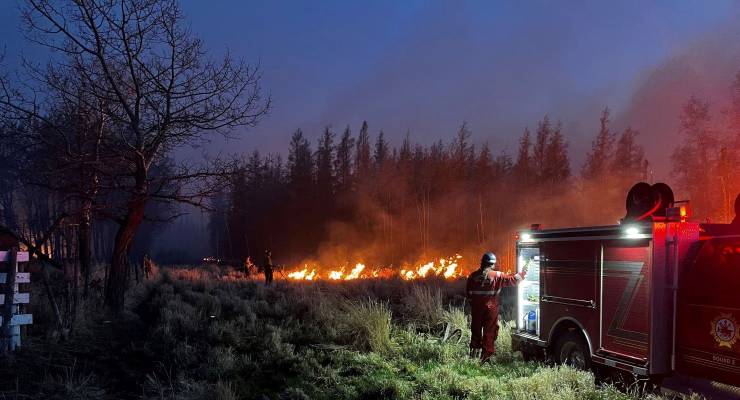
There’s no guarantee that Canadian firefighters who have just battled their worst wildfires will be able to help short-staffed brigades as Australia is bracing for its hottest and driest season since the deadly Black Summer bushfires.
Canadian Interagency Forest Fire Centre (CIFFC) chief executive Kim Connors told Crikey the government-owned corporation was in “continuous communication” with the Australasian Fire and Emergency Service Authorities Council about the “evolving bushfire situation” and would “consider” any requests.
But he said Canadian personnel were suffering from “seasonal fatigue and [deteriorating] physical and mental health” after 18.5 million hectares went up in flames this year amid some 6,500 wildfires. It’s three times the country’s record inferno of 1995, and it led to the deaths of two Canadian firefighters.
Emergency sharing between the two allied nations has been taking place since the turn of the century, though the Australian Institute for Disaster Resilience confirmed none had been requested since 2020, when nearly 100 Canadian fire experts were sent to help in Black Summer. This year, 627 Australian firefighters went to Canada (alongside volunteers from the US, Mexico and New Zealand).
International reticence is bad news for the short-staffed firefighting brigades across Australia as thousands of besieged rural residents have already been evacuated from fires — more than a month out from the first day of summer. In September, Disaster Relief Australia issued an urgent callout for volunteers to address a shortfall of 3,000 or so members — including a shortage of aviation firefighters and in fire crews in Victoria.
A few things are causing declining numbers in emergency services, former Fire and Rescue NSW commissioner Greg Mullins told Crikey. Thousands of firefighters are suffering from PTSD after Black Summer, which was made then worse by the COVID-19 lockdowns preventing “vital debriefing and counselling”.
Also, Australia was battling an ageing workforce among firefighters as younger would-be volunteers who lived through the torrid wall-to-wall coverage of Black Summer were not putting their hand up like generations before them.
All of this was made worse by the longer burning and more widespread fires in both countries. During Black Summer in Australia, “every state and territory burned at the same time”, Mullins said, preventing firefighters from going interstate. It was the same in Canada this year — every one of the 10 provinces and three territories battled infernos.
It’s not just the number of boots on the ground, Mullins said. Also compromised were “major firefighting assets such as large water-bombing helicopters and fixed-wing aircraft, all but two of which in Australia are leased from Canada and the USA”.
Amanda Lamont agrees. She’s a volunteer firefighter and the former head of the Australian Institute for Disaster Resilience during Black Summer and told Crikey the emergency management sector was already working on ways to respond to “overlapping and cascading disasters” while helping our overseas counterparts. But it was getting harder: “There is a saying in firefighting that says you fight the fire you’ve got, not the one you might get.
“I see this sentiment changing. Where once resources may more readily have been deployed interstate or overseas, [they] are now potentially being held back because the risk of mega bushfires locally is growing and creating a more risk-averse approach.
“It comes at a time when the need for people to support each other and respond to extreme and overlapping disasters either informally through civic duty, or through formal emergency management arrangements, is growing.”
Lamont is also co-founder of the Australasian Women in Emergencies Network volunteer firefighters, and said it was now “beyond doubt” in the emergency management sector that climate change was accelerating more extreme, more frequent and overlapping disasters in Australia and around the world: “We no longer need to speak rhetoric on this topic — we just need to look out the window.”
Mullins warned there was no immediate fix to Australia’s firefighting shortage: “Australia cannot afford to replace volunteer firefighters with paid firefighters — there are about 300,000 emergency service volunteers in Australia and about 30,000 paid professionals.”
But he said the Albanese government must urgently fund more paid personnel in the short term, and nearly double the emissions reduction target to 75% in the longer term. (Prime Minister Anthony Albanese said yesterday he would announce an “achievable” new target “at an appropriate time”.)
“We need to face the fact that right now we are living with the consequences of decades of climate inaction,” Mullins said. “We have a moral duty to do everything we can to ensure that we are not dooming future generations to much worse than we’re already experiencing.”








Why cannot all the climate change deniers join the CFA etc and help fight the fires?
Tony Abbott was an RFS volunteer, but climate change doesn’t cause fires he reckons, it’s the greenies.
I have a friend in the country, late sixties, back issues, health issues. The CFS are so shorthanded that they want him to stay on. Most country folk stay on well past the point where they should retire, because they know what will happen in a bushfire. And now we’re at the point where fires in the northern and southern hemispheres are overlapping. Fighting fires is some scary sh*t, but someone has to do it, and governments at all levels need to think of ways to encourage this. My friend isn’t going out to pasture any time soon. The pasture would be burnt anyway.
This is a matter of self preservation as well. My dad did 60 plus years from well before there was an RFS. He was over 70 the last time he came out with me. Almost every member of my local brigade is over 50. There is no one else.
A real symptom of population ageing and decline in the regions and how essential infrastructure and services become ‘unsustainable’.
Starts with well below replacement fertility (1970s), losing primary school, footy/cricket team, pub/shop/PO, CFA, churches, clinics etc., while farms consolidate, significant numbers of youth and working age migrate to urban areas for regional communities to become gerontocracies; observed globally especially developed world and targeted by RW parties.
I’m a farm boy, originally from South Africa. I have very early memories for trying to flog out a fire with a water-soaked hessian bag tied to a stick – aged 5 years old. It’s what you do in the country. You all pitch in and try and fight the thing.
We need to start buying fire bombers before the prices go up. Attach them to Air Force bases all around the country, (at least two planes in two bases in each State) and task, train (and hire) Air Force personnel for maintenance and crew!
Budget constraints be damned! Wake up people, this is War, and you do what you have to, NOT what you think you can afford!
And unless we start working smarter we are going to lose!
We need whatever it takes. Surely national security is at stake when people have to run into the ocean to avoid being burnt to death. It seems a no-brainer to pay and train people* to do cool burns aboriginal-style in the winter then firefight in summer. RAAF water bombers located here in our summer then rented out to N America and Europe in their summer. When dry lightning is predicted they could already be right there. Or we can wait until there’s nothing left to burn, the forests are permanently dead along with all the wildlife, as climate change rolls on. Thanks Albo and Tanya.
Are water bombers effective, or do they only look good for the pollies benefit?
Only someone who has never needed on could write that. 1000 litres of water in the right place can save lives. I know of two fire crews in my shire who were saved by light aircraft. I have personally seen fires suppressed till they could be contained by a Cessna Ag Wagon whose pilot happened to spot the fire. Oh they work, but often there is too long a lead time between ignition and initial suppression. It took 30 years to get the NSW government to believe in it, largely due to deadheads in forestry at the start.
The only problem here is that there is no such thing as Aboriginal style burns in the winter. Their fire management is far more subtle and depends greatly on the environment concerned. It is vital long term but we are looking at many years and also we have to take these steps in National Parks. Our concept of locked up wilderness has not existed for thousands of years and if we do not manage it we will see it all destroyed. Forestry likes to claim that their so called management helps and sometimes it does, but it often makes matters worse because you wind up with everything in an area the same age. Very complicated and I doubt the public have any grasp of the scale of the problem, most of them having never met a blackfella and never fought a fire.
Cheers
Thanks. I only know a little, and that from observation in the SW of WA. The forest was always expected to pay for its own upkeep, but ended up being government subsidised to some degree while workers were paid on average more than GPs, and it was all a political football until recently when logging was banned in native forest. Some of it is now National Parks, but with no old trees, just sprouted stumps, and all burnt every few years. Previous management was woeful, either clearfelling, or selective which left many tons/Ha of trash (fuel) and introduced dieback. I remember walking the Bibbulman Track to the sound of chainsaws all around, and going half a k off to the side was revealing. IMO forest and its wildlife should be given the maximum protection money can buy. It’s not only fabulous, it’s carbon.
depends greatly on the environment concerned
An environment that is now so dry, so hot, so windy and so volatile that slow burning is becoming increasingly unrealistic.
Yes, probably a much better investment in Australia’s defence forces, and for Australians generally, than the bottomless billions in nuclear submarines.
Climate change? What climate change…
Before spending billions on new aircraft, dare I suggest the govt immediately get the CSRIO research people look into swarming drone technology to fight fires. Theoretically a truck load of thousands of cheap, fire retardant carrying drones could put out fires anywhere before they get to large to control.
Just re-reading Canadian writer, John Vaillant’s book about the background and climate change implications of Canada’s 2016 Fort McMurray fire titled “Fire Weather. A true story from a hotter world”. Truly depressing and very frightening.
His title for the times we live in? The Pyrocene. A period of global, ever more massive and less controllable fires driven by out-of-control climate change caused by the previous period of human environmental destruction, the Petroscene.
“Our” response? From today’s NYT: “…almost all of the top 20 fossil fuel-producing countries plan to produce more oil, gas and coal in 2030 than they do today. If those projections hold, the world would overshoot the amount of fossil fuels consistent with limiting warming to 2 degrees Celsius — the level scientists say would result in vastly more life-threatening heat waves, drought and coastal flooding.”
Worth noting that under the US’s climate change leader Biden; the US has increased its fossil fuel exports (mainly fracked-gas) by 70% and so is building 6 more gas export terminals in the Gulf. (Where the water temperature is now in excess of 30C.) Oh, and 900 drilling licences issued for gas drilling in Alaska. And he proudly brought in his amusingly named Inflation Reduction Act which has the aim of making Chinese renewable equipment much more expensive to US consumers. To “counter China’s unfair advantage”.